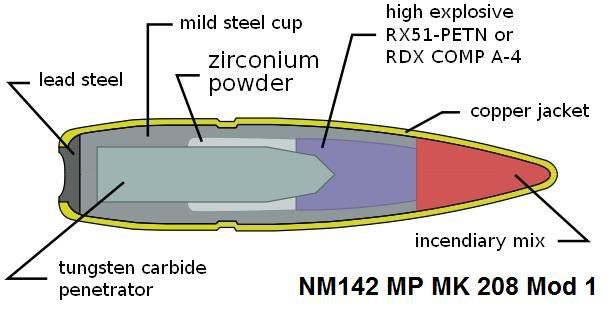7.62mm (Any variant) High Explosive Incendiary Armor Piercing Round (HEIAP)

High Explosive Incendiary/Armor Piercing Ammunition (HEIAP) is a form of shell which combines both an armor piercing capability and a high explosive effect. In this respect it is a modern version of armor piercing shell. The ammunition may also be called Semi-armor piercing high explosive incendiary (SAPHEI).
Typical of a modern HEIAP shell is the NM142 MP Mk 208 Mod 1 round designed for weapons such as heavy machine guns and anti-materiel rifles.
The primary purpose of these munitions is armor penetration, but unlike SLAP rounds (Saboted Light Armor Penetrator) which get their armor piercing ability from the propulsion of a 5.56mm tungsten heavy alloy bullet from a 7.62mm barrel using a sabot with much more energy than is usually possible from a 5.56mm round, HEIAP munitions use high explosives to "blast a path" for the penetrator. The special effect is developed when the round strikes the target. The initial collision ignites the incendiary material in the tip, triggering the detonation of the HE charge. The second (zirconium powder) incendiary charge will also ignite. This burns at a very high temperature, is not easily extinguished, and can last for 30 seconds.
The remaining element of the round is the tungsten carbide penetrator. This has a large amount of kinetic energy and will penetrate the armor as solid-cored armor piercing shot would. This will take some of the incendiary material through the armor. The MK 211 is claimed to penetrate up to an inch (25.4mm) of rolled homogeneous armor.
The triggering of the explosive charge is dependent upon the resistance of the target. If the target offers little resistance then the lack of frictional heating will prevent the incendiary from igniting and the high explosive from detonating.
Larger guns such as the British 30 mm RARDEN cannon fire APSE (Armour Piercing Special Effects) shells which are an armor piercing round with added HE effect.
This round is usually identified by a green over white paint tip mark. A rarer occurrence of a green–over red–over white paint mark scheme indicate the tracer version of this round. These tracer versions are usually only seen on cartridge feed belts in naval applications.
The headstamp on the casing can also help to identify the round as Raufoss and some common headstamps include, but not limited to: HXP89, WCC94, and FN91; or HXP, WCC, LC, or FN with different two-digit numbers as production year suffixes.
The round itself is a 13.42 gram container. While obtaining lower velocities than an ordinary round of it's kind would, in an ordinary case, the kinetic energy of the round has less importance than it's over-all function. This is becuase the round detonates on impact, both igniting the 4000 degree zirconium, setting off the C-4 explosive, the force of both of these more than compensating for any lack of energy in the propulsion, and also becuase both these explosions themselves send the carbon tungsten penetrater into the material at such a rapid velocity when combined with the initial kinetic energy that extra velocity while in flight becomes close to irrelevant. Considering the benefit of the explosive quality of the round and comparing it to the extra energy provided by the slight advantages conferred by a somewhat higher velocity, it's reasonable to assume that the extra material comes at a benefit rather than a deficit to the round.
Given it's lower velocity, the accuracy and range of the round would diminish noticeably if it wasn't for a marked difference. On every round, to compensate, extra dimples are added in order to reduce the drag. While the extra dimples do not necessarily result in a direct increase in the velocity of the round, the diminished effects ordinarily experienced by air drag in a round of it's kind is not felt at the same rate, meaning that at around 100 meters it's performance matches and begins to improve above the case it's designed for- the kinetic energy traveling. The reduced drag increases the accuracy on it's own without the help of extra velocity, although the velocity does remain higher than the case it's designed for, usually, during flight. This of course, infers to a slightly increased distance and a much more accurate flight path, although it's energy still remains slightly lower.

